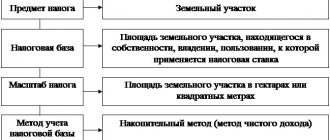Kontur.Accounting is a web service for small businesses!
Quick establishment of primary accounts, automatic tax calculation, online reporting, electronic document management, free updates and technical support.
Try it
Owning a land plot requires you to file a land tax return annually. Filing a declaration is mandatory for legal entities that own a plot of land by right of ownership, inheritance or perpetual use.
Who should report for 2021
The land tax declaration for 2021 must be submitted to the Federal Tax Service by organizations that own land plots or have the right of permanent (perpetual) use (clause 1 of Article 388, clause 1 of Article 398 of the Tax Code of the Russian Federation).
Submit the declaration, even if you are exempt from paying tax on the basis of Art. 395 of the Tax Code of the Russian Federation, for example, for a site occupied by a state public highway (clause 2 of Article 395 of the Tax Code of the Russian Federation).
The declaration is not submitted only if the land plot is not recognized as an object of taxation under clause 2 of Art. 389 of the Tax Code of the Russian Federation (Letter of the Ministry of Finance of Russia dated February 28, 2013 No. 03-02-08/5904). So, for example, the owners of premises in an apartment building do not submit a declaration in relation to the land plot underneath it.
Please note that the land tax declaration is planned to be cancelled. However, this will not happen until 2020. Therefore, it is mandatory to report for 2021.
Questions
Of course, when filling out a declaration in which taxpayers report on the calculation and payment of land tax, questions arise.
Let's consider the most relevant of them.
Is the document handed over to individual entrepreneurs?
Only companies are required to declare their tax returns on land plots.
Those businessmen who are registered with the tax office under the status of individual entrepreneurs are exempt from this obligation by law.
This is explained by the fact that the tax amount for them is calculated by the Federal Tax Service and a notification from the tax authority is sent to them for payment.
What to do if it is filled out incorrectly?
No matter how well-coordinated and clearly organized the accounting process is, practically no one can avoid errors in the calculations of budget obligations.
Therefore, situations may arise with overpayments or underpayments of taxes. They can be identified both when filling out a land tax return and after submitting it.
What should an accountant do if the tax return is filled out incorrectly?
If the company identifies errors in declarations already submitted to the INFS, then it is necessary to issue a new, so-called “Updated Declaration”.
What is an amended declaration?
The title of the document, “Updated Declaration,” already contains the answer to this question.
This means that if errors are detected, the same form is filled out again, but the document must already reflect reliable information.
When filling it out, a sign of correction is indicated in a special field on the title page. To do this, set 1 if the data in the report is corrected for the first time, or 2 if a repeated correction report has already been submitted, etc.
How to reflect an overpayment of taxes?
In each tax reporting, space is allocated for showing accrued and paid tax.
An error in overpaying tax will be reflected in the amount paid. A negative value between accrued and paid tax will certainly indicate overpaid funds.
The procedure for taxpayers to act upon detection of payment of excess funds to the budget is set out in Chapter. 12 of the Tax Code of the Russian Federation and Article 78 of the Tax Code of the Russian Federation of the same normative act.
There are some nuances here.
If errors were made when drawing up the payment order, then it is enough to show this fact in the amounts paid.
In some cases, the situation becomes more complicated when the issue is an overstatement of the tax base or the calculation of the tax levy that led to an overpayment.
In this case, the rules for adjusting the declaration are selected individually for each taxpayer.
For all organizations there is a general procedure governing the submission of any tax returns.
More details about the rules for filing tax reports can be found in Article 80 of the Tax Code of the Russian Federation.
Attention!
- Due to frequent changes in legislation, information sometimes becomes outdated faster than we can update it on the website.
- All cases are very individual and depend on many factors. Basic information does not guarantee a solution to your specific problems.
That's why FREE expert consultants work for you around the clock!
- via the form (below), or via online chat
- Call the hotline:
- 8 (800) 700 95 53
APPLICATIONS AND CALLS ARE ACCEPTED 24/7 and 7 days a week.
Land tax
The declaration form is new!
The declaration for 2021 is submitted in the form approved by Order of the Federal Tax Service of Russia dated May 10, 2017 No. ММВ-7-21/ (as amended by Appendix No. 1 to Order of the Federal Tax Service of Russia dated August 30, 2018 No. ММВ-7-21/). In fact, this is a completely new form of reporting.
Here's what, for example, has changed in the updated form:
- Section 2 has been supplemented with a new line 245 “Amount of tax benefit (in rubles) (clause 2 of Article 387 of the Tax Code of the Russian Federation)” (filled in if local authorities establish a tax benefit for the payer in the form of a rate reduction);
- the new filling procedure takes into account the possibility of simultaneous application of coefficients Kv and Ki (if the value of each of them is different from one);
- The Appendix “Land Category Codes” to the filling procedure is set out in a new edition (now contains codes for such categories of land as lands for defense in populated areas/lands for security in populated areas/lands for customs needs).
Also see “ New land tax reporting for 2021 ”.
Filling out the declaration for 2018
We recommend filling out the declaration in the following sequence: first the title page, then section. 2 and finally section. 1.
Title page
In the “KPP” field, the code assigned during registration with the tax authority to which the declaration is submitted is indicated (clause 3.2.1 of the Procedure).
The field “at location (accounting) (code)” is filled out in accordance with Appendix No. 3 to the Procedure (clause 3.2.7 of the Procedure). For example, when submitting a calculation for the location of a land plot (share of a land plot), you need to indicate code “270” (Appendix No. 3 to the Procedure).
Section 2: calculation of land tax
Complete Section 2 for each site. In line 020, indicate OKTMO. You can find it on the Federal Tax Service website – https://nalog.ru/rn77/service/oktmo/.
Find the land category code for line 030 in Appendix No. 5 to the Procedure for filling out the declaration.
The category of land, its purpose and permitted use are indicated in the extract from the Unified State Register of Land Registers for the land plot, the certificate of ownership or the purchase and sale agreement. This information can also be found on the Rosreestr website using the cadastral number of the plot - https://rosreestr.ru/wps/portal/online_request.
In lines 050 and 110, indicate the cadastral value of the plot. If you are not the only owner of the plot, indicate the share of ownership in line 060, multiply lines 050 and 060, and show the result in line 110.
Take the cadastral value of the land as of January 1 of the year for which you are calculating the tax (clause 1 of Article 391 of the Tax Code of the Russian Federation). You can find it out by the cadastral number of the plot on the Rosreestr website https://rosreestr.ru/wps/portal/online_request.
The tax rate is reflected in line 120 (clause 5.14 of the Procedure).
The land tax rate is set by the local government. If he has not done this, the general rate applies - 1.5%, and for some categories of land, for example agricultural land - 0.3% (clause 3 of Article 394 of the Tax Code of the Russian Federation). The rate for your site can be clarified on the Federal Tax Service website - https://www.nalog.ru/rn77/service/tax/.
In lines 130 – 140, enter “12” and “1.0—“. If you did not own the plot for the entire year, indicate the full months of ownership and calculate the Kv Coefficient by dividing the number of months of ownership by 12. For example, if you owned the plot for 11 months, the Kv is equal to 0.9167 (11 months / 12 months) (Letter of the Federal Tax Service dated 06.04. 2018 No. BS-4-21/).
In line 150, indicate the tax amount - this is the product of lines 110, 120 and 140. Rewrite the amount from line 150 to line 250. In line 170, if there are no benefits, enter “1.0—“.
Fill in lines 070 – 100, 160, 180 – 245 only if you are using benefits. If not, put dashes.
Federal benefits are established in Art. 395 Tax Code of the Russian Federation. You can check whether there are benefits at the local level on the Federal Tax Service website - https://www.nalog.ru/rn77/service/tax/ (clause 2 of Article 387 of the Tax Code of the Russian Federation). Land tax benefit codes for filling out the declaration are given in Appendix 6 to the Procedure for filling it out.
Example of calculating land tax
The organization owns a site for long-term storage of cars with a cadastral value of 64,105,865 rubles.
- Tax rate – 0.1%.
- The calculated tax amount for the year is RUB 64,106. (RUB 64,105,865 x 0.1%).
- Advance payments for the 1st, 2nd and 3rd quarters – 16,027 rubles each. (RUB 64,106 / 4).
- Tax payable at the end of the year – 16,025 rubles. (RUB 64,106 – (RUB 16,027 x 3)).
Section 1: land tax amount
Section 1 is completed for all land plots that are objects of taxation (clause 4.1 of the Procedure). It reflects the amount of tax calculated at the end of the year (including advance payments for reporting periods). In this case, for each OKTMO you need to fill out lines 010 – 040 separately.
When filling out line 021, you should add up the tax amounts indicated in line 250 of all sections. 2, which have one OKTMO and BSC (clause 3, clause 4.2 of the Procedure).
Lines 023, 025 and 027 reflect the amounts of advance payments payable to the budget for the 1st, 2nd and 3rd quarters, respectively (clause 4, clause 4.2 of the Procedure).
Let's look at a sample of filling out a land tax return for 2018.
Example:
- the organization is registered for tax purposes at its location with the Federal Tax Service of Russia No. 27 in Moscow (tax authority code - 7727);
- TIN 7727098760/KPP 772701001;
- the organization owns one land plot (OKTMO code – 45908000);
- the period of ownership of the land plot in 2021 is 12 months;
- the cadastral value of the land plot as of January 1, 2021 was 58,000,000 rubles;
- On November 1, 2021, information about changes in the cadastral value of the land plot was entered into the Unified State Register of Real Estate due to a change in the area of the plot - the cadastral value was RUB 57,500,000;
- The cadastral number of the plot before the change in cadastral value is 77:06:0004005:71. From November 1, 2021, the cadastral number of the plot is 77:06:0004005:77;
- land tax rate - 1.5% of the cadastral value of the site (clause 4, part 1, article 2 of the Moscow Law of November 24, 2004 N 74);
- the organization has no grounds for applying tax benefits;
- during the tax period, the organization pays advance payments for land tax (clause 2 of article 397 of the Tax Code of the Russian Federation, part 2 of article 3 of the Moscow Law of November 24, 2004 No. 74).
Land tax rates
Tax rates are established by regulatory legal acts of representative bodies of municipalities and the laws of Moscow, St. Petersburg and Sevastopol.
Article 394 of the Tax Code establishes the maximum possible land tax rates.
They are differentiated depending on the categories of land and (or) permitted use of the land plot, as well as on the location of the taxable object.
The following lands are taxed at a rate of 0.3%:
- agricultural purposes;
- occupied or intended for the construction of engineering facilities of housing and communal services and residential buildings;
- purchased (provided) for personal subsidiary plots, gardening, market gardening or livestock farming, as well as summer cottage farming;
- limited in circulation in accordance with the legislation of the Russian Federation, provided to ensure defense, security and customs needs.
All other lands are taxed at a rate of 1.5%.
For inappropriate use of land, a company can be fined under Article 8.8 of the Code of Administrative Offenses of the Russian Federation.









